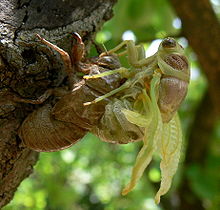- Chitin
-
 Structure of the chitin molecule, showing two of the N-acetylglucosamine units that repeat to form long chains in β-1,4 linkage.
Structure of the chitin molecule, showing two of the N-acetylglucosamine units that repeat to form long chains in β-1,4 linkage.
Chitin (C8H13O5N)n (
 /ˈkaɪtɨn/) is a long-chain polymer of a N-acetylglucosamine, a derivative of glucose, and is found in many places throughout the natural world. It is the main component of the cell walls of fungi, the exoskeletons of arthropods such as crustaceans (e.g., crabs, lobsters and shrimps) and insects, the radulas of mollusks, and the beaks of cephalopods, including squid and octopuses. In terms of structure, chitin may be compared to the polysaccharide cellulose and, in terms of function, to the protein keratin. Chitin has also proven useful for several medical and industrial purposes.
/ˈkaɪtɨn/) is a long-chain polymer of a N-acetylglucosamine, a derivative of glucose, and is found in many places throughout the natural world. It is the main component of the cell walls of fungi, the exoskeletons of arthropods such as crustaceans (e.g., crabs, lobsters and shrimps) and insects, the radulas of mollusks, and the beaks of cephalopods, including squid and octopuses. In terms of structure, chitin may be compared to the polysaccharide cellulose and, in terms of function, to the protein keratin. Chitin has also proven useful for several medical and industrial purposes.The structure of chitin was solved by Albert Hofmann for which he received his doctorate.
Contents
Etymology
The English word "chitin" comes from the French word chitine, which first appeared in 1836. These words were derived from the Greek word chitōn, meaning mollusk, that is, influenced by the Greek word khitōn, meaning "tunic" or "frock". That word may come from the Central Semitic word *kittan, the Akkadian words kitû or kita’um, meaning flax or linen, and the Sumerian word gada or gida.[1]
A similar word, "chiton", refers to a marine animal with a protective shell (also known as a "sea cradle").
Chemistry, physical properties and biological function
Chitin is a modified polysaccharide that contains nitrogen; it is synthesized from units of N-acetylglucosamine (to be precise, 2-(acetylamino)-2-deoxy-D-glucose). These units form covalent β-1,4 linkages (similar to the linkages between glucose units forming cellulose). Therefore, chitin may be described as cellulose with one hydroxyl group on each monomer substituted with an acetyl amine group. This allows for increased hydrogen bonding between adjacent polymers, giving the chitin-polymer matrix increased strength.
In its unmodified form, chitin is translucent, pliable, resilient, and quite tough. In arthropods, however, it is often modified, becoming embedded in sclerotin, a tanned proteinaceous matrix, which forms much of the exoskeleton. In its pure form, chitin is leathery, but in most invertebrates it occurs largely as a component of composite materials. Combined with say, calcium carbonate, as in the shells of Crustacea, it produces a much stronger composite, harder and stiffer than pure chitin, tougher than the mineral substance alone.[2] Another difference between pure and composite forms can be seen by comparing the flexible body wall between the segments of a caterpillar (mainly chitin) to the stiff, light elytron of a beetle (containing a large proportion of sclerotin).[3]
Fossil record
Chitin was present in the exoskeletons of Cambrian arthropods such as trilobites. The oldest preserved chitin dates to the Oligocene, about 25 million years ago.[4]
Uses
Agriculture
Most recent studies point out that chitin is a good inducer for defense mechanisms in plants.[5] It has also been assessed as a fertilizer that can improve overall crop yields.[6] The EPA regulates chitin for agricultural use within the USA.[7] Chitosan is prepared from chitin by deacetylation.
Industrial
Chitin is used in industry in many processes. It is used as an additive to thicken and stabilize foods and pharmaceuticals. It also acts as a binder in dyes, fabrics, and adhesives. Industrial separation membranes and ion-exchange resins can be made from chitin. Processes to size and strengthen paper employ chitin.[citation needed]
Medicine
Chitin's properties as a flexible and strong material make it favorable as surgical thread. Its biodegradibility means it wears away with time as the wound heals. Moreover, chitin has some unusual properties that accelerate healing of wounds in humans.[8]
Occupations associated with high environmental chitin levels, such as shellfish processors, are prone to high incidences of asthma. Recent studies have suggested that chitin may play a role in a possible pathway in human allergic disease. To be specific, mice treated with chitin develop an allergic response, characterized by a build-up of interleukin-4, expressing innate immune cells. In these treated mice, additional treatment with a chitinase enzyme abolishes the response.[9]
See also
- Biopesticide
- Chitobiose
- Chitosan (natural biocontrol for agricultural and horticultural uses)
- Lorica
- Sporopollenin
- Tectin
References
- ^ American Heritage dictionary of the English Language: Fourth Edition. 2000. entry for chiton
- ^ Campbell, N. A. (1996) Biology (4th edition) Benjamin Cummings, New Work. p.69 ISBN 0-8053-1957-3
- ^ Gilbert, Lawrence I. (2009). Insect development : morphogenesis, molting and metamorphosis. Amsterdam Boston: Elsevier/Academic Press. ISBN 9780123751362.
- ^ Briggs, DEG (29 January 1999). "Molecular taphonomy of animal and plant cuticles: selective preservation and diagenesis". Philosophical Transactions of the Royal Society B: Biological Sciences 354 (1379): 7–17. doi:10.1098/rstb.1999.0356. PMC 1692454. http://www.pubmedcentral.nih.gov/articlerender.fcgi?tool=pmcentrez&artid=1692454.
- ^ "Linden, J., Stoner, R., Knutson, K. Gardner-Hughes, C. “Organic Disease Control Elicitors”. Agro Food Industry Hi-Te (p12-15 Oct 2000)". http://www.yeacrops.com/Crop%20Protection%20Article.pdf.
- ^ "Chitosan derived from chitin, Chitosan Natural Biocontrol for Agricutlural & Horticultural use". http://en.wikipedia.org/wiki/Chitosan#Agricultural_.26_Horticultural_use.
- ^ "EPA: Chitin; Poly-N-acetyl-D-glucosamine (128991) Fact Sheet". http://www.epa.gov/pesticides/biopesticides/ingredients/factsheets/factsheet_128991.htm.
- ^ Bhuvanesh Gupta,Abha Arorab,Shalini Saxenaa and Mohammad Sarwar Alam (July 2008). "Preparation of chitosan–polyethylene glycol coated cotton membranes for wound dressings: preparation and characterization". Polymers for Advanced Technologies 20: 58–65. doi:10.1002/pat.1280. http://www3.interscience.wiley.com/cgi-bin/fulltext/121487185/PDFSTART.</
- ^ Tiffany A. Reese, Hong-Erh Liang, Andrew M. Tager, Andrew D. Luster, Nico Van Rooijen, David Voehringer & Richard M. Locksley (3 May 2007). "Chitin induces accumulation in tissue of innate immune cells associated with allergy". Nature 447 (7140): 92–96. doi:10.1038/nature05746. PMC 2527589. PMID 17450126. http://www.nature.com/nature/journal/v447/n7140/edsumm/e070503-13.html.
- Martín-Gil FJ, Leal JA, Gómez-Miranda B, Martín-Gil J, Prieto A, Ramos-Sánchez MC. "Low temperature thermal behaviour of chitins and chitin-glucans". Thermochim. Acta, 1992, vol. 211, pp. 241–254.
External links
- Horseshoe Crab Chitin Research
- Information about Chitin (Heppe Medical Chitosan)
- MeSH Chitin
- Chitin Product Information from China GreatVista Chemicals
Types of carbohydrates General: Geometry Monosaccharides Aldodiose (Glycolaldehyde)Ketopentose (Ribulose, Xylulose)
Aldopentose (Ribose, Arabinose, Xylose, Lyxose)
Deoxy sugar (Deoxyribose)>7Multiple Other oligosaccharidesGlucose/Glucan: Glycogen · Starch (Amylose, Amylopectin) · Cellulose · Dextrin/Dextran · Beta-glucan (Zymosan, Lentinan, Sizofiran) · Maltodextrin
Fructose/Fructan: Inulin · Levan beta 2→6
N-Acetylglucosamine: Chitinbiochemical families: prot · nucl · carb (glpr, alco, glys) · lipd (fata/i, phld, strd, gllp, eico) · amac/i · ncbs/i · ttpy/i Categories:- Biomolecules
- Polysaccharides
- Acetamides
Wikimedia Foundation. 2010.

